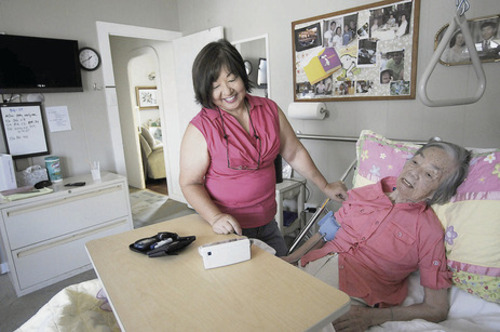169,000 in isles help care for ill, seniors

Laurie Kaneshiro checks the blood pressure of her 84-year-old mother, Yukie Kuwahara, who is dependent on Kaneshiro as a caregiver. Kaneshiro left her full-time job as an interior designer to care for her mother.
Kaimuki resident Laurie Kaneshiro quit her 80-hour-a-week interior design job in June 2010 to take on the even more grueling role of caring for her ailing 84-year-old mother, who no longer can walk or carry on with daily activities on her own.
Though she can’t speak, Yukie Kuwahara’s huge smile and peaceful demeanor are indicative of her happiness of still living at home with her family.
But the stress her daughter endures daily — being on call 24 hours a day, at least five days a week — is beginning to take its toll.
Kaneshiro, who also takes care of her blind 96-year-old father-in-law every other weekend, is among 169,000 regular caregivers 18 years and older in Hawaii who assist elderly, chronically ill or disabled family members or friends without pay, according to a report released last week by the AARP Public Policy Institute in Washington, D.C.
AARP compiled the 2009 data from a national telephone survey by the U.S. Centers for Disease Control and Prevention and a separate study of 1,480 caregivers by AARP and the National Alliance for Caregiving.
Including occasional caregivers, the study showed there were 247,000 island residents who provide assistance without pay at least once a year. The assistance could be feeding, bathing, grooming, driving, helping pay bills or managing medication.
Don't miss out on what's happening!
Stay in touch with breaking news, as it happens, conveniently in your email inbox. It's FREE!
AARP said the economic value of the unpaid labor in Hawaii totaled $1.9 billion, up from $1.45 billion in a 2007 survey. The total value of unpaid care nationally is estimated at $450 billion, the organization said.
Like many caregivers in Hawaii, Kaneshiro is torn between her desire to care for her mother at home with mounting burdens of providing that care and trying to work 30 hours a week in a interior design business she launched. Her mother goes to senior day care twice a week, which basically eats up her Social Security checks each month. The family has already spent $12,000 to modify a bathroom for her mother, who is in a wheelchair and needs another $8,000 to build a wheelchair ramp from the bedroom to garage.
"There’s a long-standing tradition in Hawaii of wanting to care for one’s elderly," said Bruce Bottorff, associate state director for AARP Hawaii. "Because caregiving for aging relatives is so central to life in Hawaii, we’re finding that a lot of families are already at the tipping point. Caring for older relatives and friends has become more widespread and difficult. Older adults are more likely to have multiple complex chronic health conditions, and locating and accessing quality paid help to supplement the family care in the home is a constant struggle."
Kaneshiro, 57, hasn’t been able to get help from Medicaid or other programs to pay for in-home care, though Medicaid will pay for a nursing home, she said.
"It’s really frustrating," Kaneshiro said. "All of us baby boomers out there … I better save my money because if it’s going to be like this later, we’re not going to be able to have any home care."
Caregiving, which according to the study predominantly affects women, will take a greater toll on their ability to save for their own retirement and could affect their health, AARP said.
Kaneshiro, who has hypertension, high blood pressure and high cholesterol, which she attributes to stress related to caregiving, is at a crossroads: deciding whether it’s the right time to relinquish her constant caregiving role by putting her mother, who moved to Hawaii from Oregon in February 2009, into a nursing home.
"I love my mom dearly. I want to do this for her, but at some point I’m not going to be able to do it anymore," Kaneshiro said. "Caregiving is not something I was trained to do. The mental stress of dealing with whether I’m doing the right thing for her, whether I researched everything that’s available out there that she could get and also the day-to-day conflicts that arise, is really high."
The average caregiver, the study said, is a 49-year-old woman who works outside the home and spends nearly 20 hours a week as a caregiver through the course of five years.
Waikiki resident Sharon Bryant, 56, quit her job as a reservationist at the Waikiki Beach Marriott Resort & Spa in 2005 to care for her 87-year-old mother, Alice Lovell, after she fell down her condo stairs and hit her head.
"She went into a care home for a year and a half, and we couldn’t afford the $7,000 a month anymore," said Bryant, whose family lives on the sole income of her husband. "She’s getting older and slower, and I’m getting older and more impatient. We can’t buy this and can’t do that, but it’s all good. She’s my only mom."
As baby boomers reach retirement age, there will likely be more pressure on Hawaii’s families to provide the necessary long-term support, according to AARP.
"The current generation of older people … they have more access to family caregivers right now than probably any previous generation," Bottorff said of baby boomer caregivers. "Because of the way our society is aging, we’re going to inevitably have less access to family caregivers not only because of demographics, but changes in family structure — more women working outside the home, etc. — and that’s going to put more pressure on the system as well. If we think it’s tough now, it’s going to be getting a lot worse."



